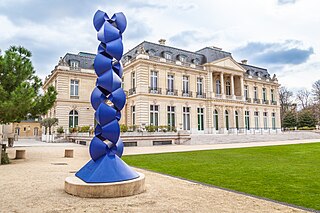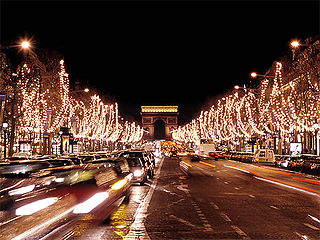Related Research Articles

New Caledonia is a group of islands in the southwest Pacific Ocean, 220 km (140 mi) southwest of Vanuatu and 1,210 km (750 mi) east of Australia. Located 16,100 km (10,000 mi) from Metropolitan France, it forms a sui generis collectivity of the French Republic, a legal status unique in overseas France and enshrined in a dedicated chapter of the French Constitution.

The geography of New Caledonia (Nouvelle-Calédonie), an overseas collectivity of France located in the subregion of Melanesia, makes the continental island group unique in the southwest Pacific. Among other things, the island chain has played a role in preserving unique biological lineages from the Mesozoic. It served as a waystation in the expansion of the predecessors of the Polynesians, the Lapita culture. Under the Free French it was a vital naval base for Allied Forces during the War in the Pacific.

The 16th arrondissement of Paris is the westernmost of the 20 arrondissements of Paris, the capital city of France. Located on its Right Bank, it is adjacent to the 17th and 8th arrondissements to the northeast, as well as to the suburb of Boulogne-Billancourt, Hauts-de-Seine to the southwest. Opposite the Seine are the 7th and 15th arrondissements.

The 8th arrondissement of Paris is one of the 20 arrondissements of the capital city of France. In spoken French, the arrondissement is colloquially referred to as le huitième.

Nouméa is the capital and largest city of the French special collectivity of New Caledonia and is also the largest francophone city in Oceania. It is situated on a peninsula in the south of New Caledonia's main island, Grande Terre, and is home to the majority of the island's European, Polynesian, Indonesian, and Vietnamese populations, as well as many Melanesians, Ni-Vanuatu and Kanaks who work in one of the South Pacific's most industrialised cities. The city lies on a protected deepwater harbour that serves as the chief port for New Caledonia.

Caldoche is the name given to inhabitants of the French overseas collectivity of New Caledonia of European ethnic origin who have settled in New Caledonia since the 19th century. The formal name to refer to this particular population is Calédoniens, short for the very formal Néo-Calédoniens, but this self-appellation technically includes all inhabitants of the New Caledonian archipelago, not just the Caldoche.

La Madeleine is a commune in the Nord department in northern France.

Islam in New Caledonia is a minority faith, consisting of 2.6% of population or 6,357 people. The community is largely ethnic Javanese, and primarily speaks French, and Arabic or Indonesian, causing a linguistic gap between them and neighbouring Anglophone Muslim communities in Australia and Fiji. There is an Islamic centre in Nouméa, and another in Bourail catering to Algerian-Caledonians.

Japanese in the United Kingdom include British citizens of Japanese ancestry or permanent residents of Japanese birth or citizenship, as well as expatriate business professionals and their dependents on limited-term employment visas, students, trainees and young people participating in the UK government-sponsored Youth Mobility Scheme.
Japanese people in France are French residents and citizens of Japanese ancestry, including both those who have settled in France permanently and those born in the country, along with a significant community of short-term expatriates who spend at most a few years in the country before moving on.
There is a small Japanese community in India which consists mainly of expatriates from Japan or Indian-born people of Japanese ancestry.
Japanese people in China are Japanese expatriates and emigrants and their descendants residing in Greater China. In October 2018, there were 171,763 Japanese nationals living in the People's Republic of China, and 24,280 Japanese nationals living in the Republic of China (Taiwan).
Japanese New Zealanders are New Zealand citizens of Japanese ancestry, which may include Japanese immigrants and descendants born in New Zealand. Japanese people first began immigrating to New Zealand in the 1890s. Until 1920, 14 Japanese citizens resided in New Zealand. Japanese immigration was halted during the period of the Pacific War and recommenced around the 1950s. From this period onwards, Japanese immigration remained small until the 1990s. In 1997, Japanese peoples were the 19th-largest ethnic group in New Zealand. As of the 2018 census, 18,141 New Zealand residents identify themselves as Japanese New Zealanders.
In the early 9th century, the emperor Charlemagne mandated all churches to give lessons in reading, writing and basic arithmetic to their parishes, and cathedrals to give a higher-education in the finer arts of language, physics, music, and theology; at that time, Paris was already one of France's major cathedral towns and beginning its rise to fame as a scholastic centre. By the early 13th century, the Île de la Cité Notre-Dame cathedral school had many famous teachers, and the controversial teachings of some of these led to the creation of a separate Left-Bank Sainte-Genevieve University that would become the centre of Paris's scholastic Latin Quarter best represented by the Sorbonne university.

The Japanese School of Brussels a.s.b.l. is a Japanese international school located in Auderghem, Brussels. The school serves elementary and junior high school levels. It is Belgium's only Japanese international school. The Japanese Supplementary School of Brussels, a supplementary school operated on Saturdays, is held on the premises of the JSB.

The Paris Metropolitan Area includes a Japanese community. In 2023, the official number of Japanese residents in Paris was 10,592, compared to 16,277 a decade prior.

Hoshū jugyō kō (補習授業校), or hoshūkō (補習校), are supplementary Japanese schools located in foreign countries for students living abroad with their families. Hoshū jugyō kō educate Japanese-born children who attend local day schools. They generally operate on weekends, after school, and other times not during the hours of operation of the day schools.

An independence referendum was held in New Caledonia on 4 October 2020. The poll was the second to be held under the terms of the Nouméa Accord, following a similar referendum in 2018.

Balabio Island is a small Pacific island of New Caledonia administered from Poum in the North Province.
References
- ↑ Japanese in New Caledonia: 120 years, December 2012, retrieved January 9, 2023
- ↑ Howard (1983), p. 108
- 1 2 3 Wurm et al. (1996), p. 393
- ↑ Thomas (2005), p. 334
- 1 2 Moore (1990), p. 87
- ↑ The Pacific War in Relation to Japanese settlers in Papua New Guinea [ permanent dead link ], South Pacific Study Vol. 17, No. 2, 1997, Hiromitsu Iwamoto, Kagoshima University Repository
- ↑ Crocombe (2001), p. 51
- ↑ Winer (1997), p. 156
- 1 2 Crocombe (2007), p. 45-6
- ↑ Burchett (1942), p. 147-8
- ↑ "大洋州の補習授業校一覧(平成25年4月15日現在)" (). MEXT. Retrieved on February 13, 2015.
- ↑ "ニューカレドニア日本語補習校 (Ecole Japonaise de la Nouvelle-Calédonie)." Association Japonaise en Nouvelle-Calédonie (ニューカレドニア日本人会 Nyū Karedonia Nihonjinkai). Retrieved on January 14, 2017.